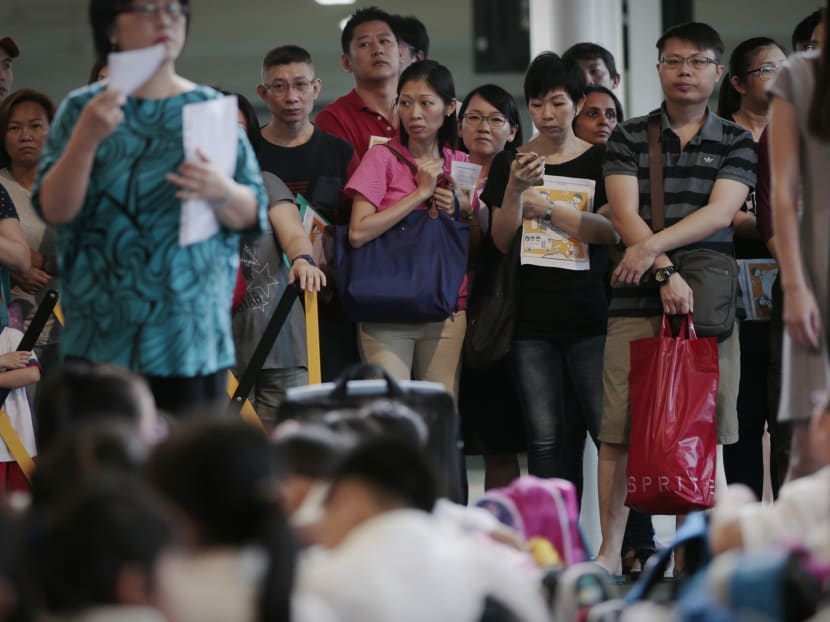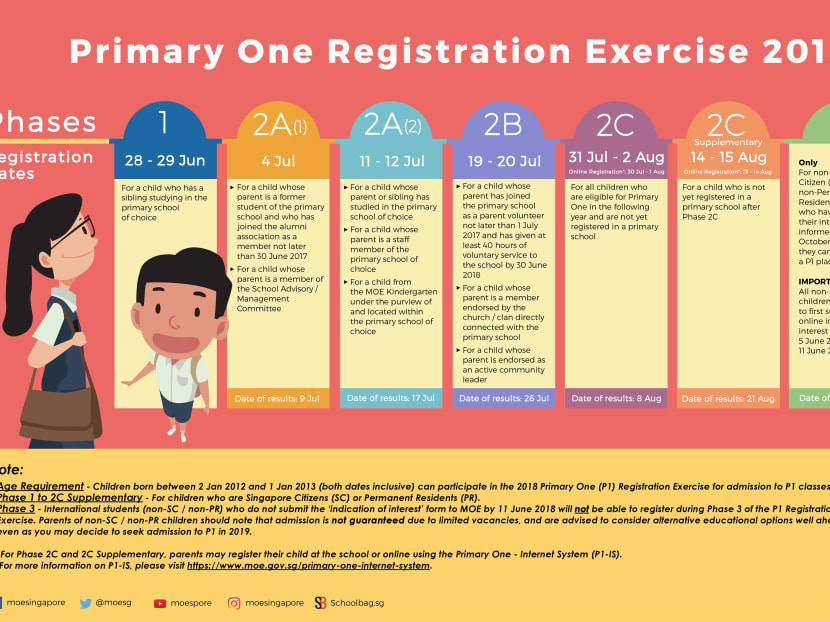MOE scraps manual balloting for P1 registration
SINGAPORE — Manual balloting for primary school places will be replaced by computerised balloting effective from this year’s Primary 1 (P1) exercise, the Ministry of Education (MOE) announced on Tuesday (March 20).

Parents of primary one students on the first day of school at Unity Primary School. TODAY file photo
SINGAPORE — Manual balloting for primary school places will be replaced by computerised balloting effective from this year’s Primary 1 (P1) exercise, the Ministry of Education (MOE) announced on Tuesday (March 20).
This will be done at the ministry’s headquarters in Buona Vista, and parents will no longer need to make arrangements to physically attend the balloting in schools.
The registration exercise this year will be open from June 28 to Oct 31, for children born between Jan 2, 2012 and Jan 1, 2013.
MOE said in a media release that the change is to streamline the registration processes and make it more convenient for applicants.
“Similar to the manual process, computerised balloting ensures that all registrants that need to ballot are assured of an equal chance for admission into the school,” it said.
What happens during the yearly exercise is that if the number of applications exceed the vacancies at a school during a particular registration phase and under the home-school distance category, the remaining vacancies are allocated by ballot, which is done manually in the schools.

As with the previous balloting process, parents should refer to the MOE website this year to find out which schools require balloting at the end of each registration phase.
Information on the number of applications received and the number of remaining vacancies in each school will continue to be made available on the website and updated at the end of each day during the registration period.
A letter will be sent to parents at the end of each phase of the exercise. They will also be notified of the registration outcome, including the balloting result — through SMS — on the day that the registration result is announced.
MOE said that the computerised balloting is a “secure process” which has been used for “many years” for the Secondary 1 posting and the joint admission exercises. However, it did not elaborate on why it chose to introduce the system for the P1 registration only now.
Ms Shireen Koh, who works in retail and has a son in kindergarten, said that computerised balloting should have been introduced years ago. “It’s puzzling why they decide to do it now since they have used it for secondary schools. But it’s better late than never.”
Other parents approached by TODAY also said that the move is long overdue and will save them the hassle of going down to schools.
Sales manager Liza Jaafar, 37, whose daughter is a Primary 3 student at Marymount Convent School, recalled that she had to take urgent leave in order to ballot for a place at the school: “I emailed my supervisor, dropped everything and left the office. It was like the most important thing in the world.”
NEW TWO-STEP PROCESS FOR INTERNATIONAL STUDENTS
For the P1 computerised balloting, the registration and eligibility phases for children of Singapore citizens and Singapore permanent residents will remain unchanged.
International students, however, will have to undergo a two-step process when they register for P1 places from this year. This is due in part to the growing number of applications from this group, an MOE spokesperson told TODAY.
Between June 5 and 11, parents of international students who wish to enrol their children in a primary school here must submit an online “indication of interest” form through the MOE’s P1 website.
The ministry will then notify parents in October if their children are offered a place in a school. After that, they must register in person at the designated school during Phase 3 of this year’s registration exercise in late October.
Previously, parents registered at the schools, and MOE processed all the applications centrally.
International students who do not submit the “indication of interest” form to MOE by June 11 will not be able to register during Phase 3 of the P1 registration exercise.
The ministry stressed that parents of international students should note that an “indication of interest” is not considered as registration.
MORE APPLICATIONS FROM INTERNATIONAL STUDENTS
Over the years, MOE has been receiving more applications from international students for Phase 3 admissions, but it did not provide figures.
When asked, its spokesperson would only say that for the P1 registration in 2016, it rejected around 1,800 applications from international students to start school in 2017.
International students comprise about 5 per cent of the student population in primary and secondary schools as well as junior colleges.
With the ministry receiving more applications, this has increased the time needed to process the paperwork, because there are some checks and verifications that have to be done with other government agencies, including the validity of employment passes.
“As such, there is a need to refine processes to better manage the volume,” the spokesperson told TODAY.
With the “indication of interest” form submitted as part of the new two-step process, it will allow the ministry to conduct preliminary checks on the submitted documents, the spokesperson added. This will help to speed up the release of registration outcomes to international students in October, one month earlier than in past years.
It will also give international students who are unsuccessful in seeking admission to P1 more time to consider other education options, the spokesperson said.






